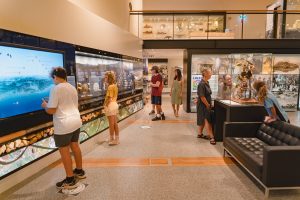Museums & Galleries of NSW knows a lot about gallery audiences, having undertaken two major studies, published as Guess Who’s Going to the Gallery–NSW State Report (2011) and Guess Who’s Going to the Gallery–Queensland Report (2013).
The NSW study identified an “average” or typical gallery audience, establishing that visitors are motivated by specific things and have particular patterns of visitation. The Queensland study, undertaken in partnership with Museums & Galleries Queensland, confirmed that many of the audience characteristics identified in NSW, such as age, gender, proximity to the gallery, annual household income and level of education were indeed markers of an “average” gallery audience.
Most people who work or volunteer in a museum or gallery know that there are audience differences that historically have been difficult to describe. In 2014, after a number of conversations, Museum of the Riverina, Newcastle Museum, and Tweed Regional Museum agreed to partner with us to undertake a version of the gallery study, for museums. The aim of the project was to identify if an “average museum audience” exists and, if so, how it might differ, or be similar to, the average gallery audience.
… Some of the results are really surprising. It is the unexpected and unknown that is always the most fascinating.
After 18 months of exhaustive analysis and data collection we now know that there is an average museum audience and it differs from the average gallery audience in the following ways.
Museum audiences have:
- a higher percentage of intra-state and interstate tourists
- a higher percentage of males
- a higher percentage of 65+ and retirees
- higher levels of annual household income, and
- a higher level of first-time visitors
In addition, they are more likely to:
- involve social groups (including children)
- stay longer
- cite “word of mouth” as a source of information
- be motivated to see the general collection
- rate the experience as “terrific”
They are less likely to:
- attend a public program
- attend performing arts events
- come alone
The median household income of the typical museum audience is $80,000 pa and when compared to the general population, there is a higher frequency of post high-school education represented, with around half having completed at least one tertiary degree. One fifth finished formal education in high school, and collectively, individuals are as likely to be a return visitor as they are to be a first-time visitor. Museum audiences value the social aspects of attending; over half come with family and friends and around a quarter attend with their spouse or partner.
Only a small percentage declare that they don’t use the internet (5%) and many report the importance of printed publications, including the local newspaper, as the source of information about their visit.
Tourists (those who live more than 50 km from the museum) are equally likely to stay in paid accommodation as with family or friends, with around a third of those visiting a region staying four nights or more. Just under half of all tourists surveyed were in the 45-64 age range, and were as likely to attend with their “spouse or partner”, with “family and friends with children”, or with “family and friends without children”.
Museum audiences go to “connect with local history” and to “learn new things”. Those aged 15-24 are more driven by the latter, with the 65 and over group being more likely to want to encounter local history.
There were several similarities confirmed between gallery and museum audiences and these include:
- a desire to connect with and support communities
- a noticeable proportion of tourists
- a predominately female demographic
- a representation of lower income groups
- a representation of older age groups
- a likeliness to attend the cinema and use public libraries
Importantly too, both audiences express “very high” levels of satisfaction with their visitor experience, with almost all rating their museum or gallery visit as either good or terrific, highlighting the quality of exhibitions and the service provided by volunteers and staff for particular praise.
The report was launched this week in Wagga Wagga by Michael Brealey, Director Policy and Strategy with Arts NSW. It was warmly received with several people commenting on the importance and timeliness of the research. Julie Baird Newcastle Museum Manager said:
“The information gathered from this project tells a detailed story of who our audiences are, what inspires them and how we compare to other similar museums. Some of the results are really surprising. It is the unexpected and unknown that is always the most fascinating”.
If you would like to know more about museum audiences, read the full report.






